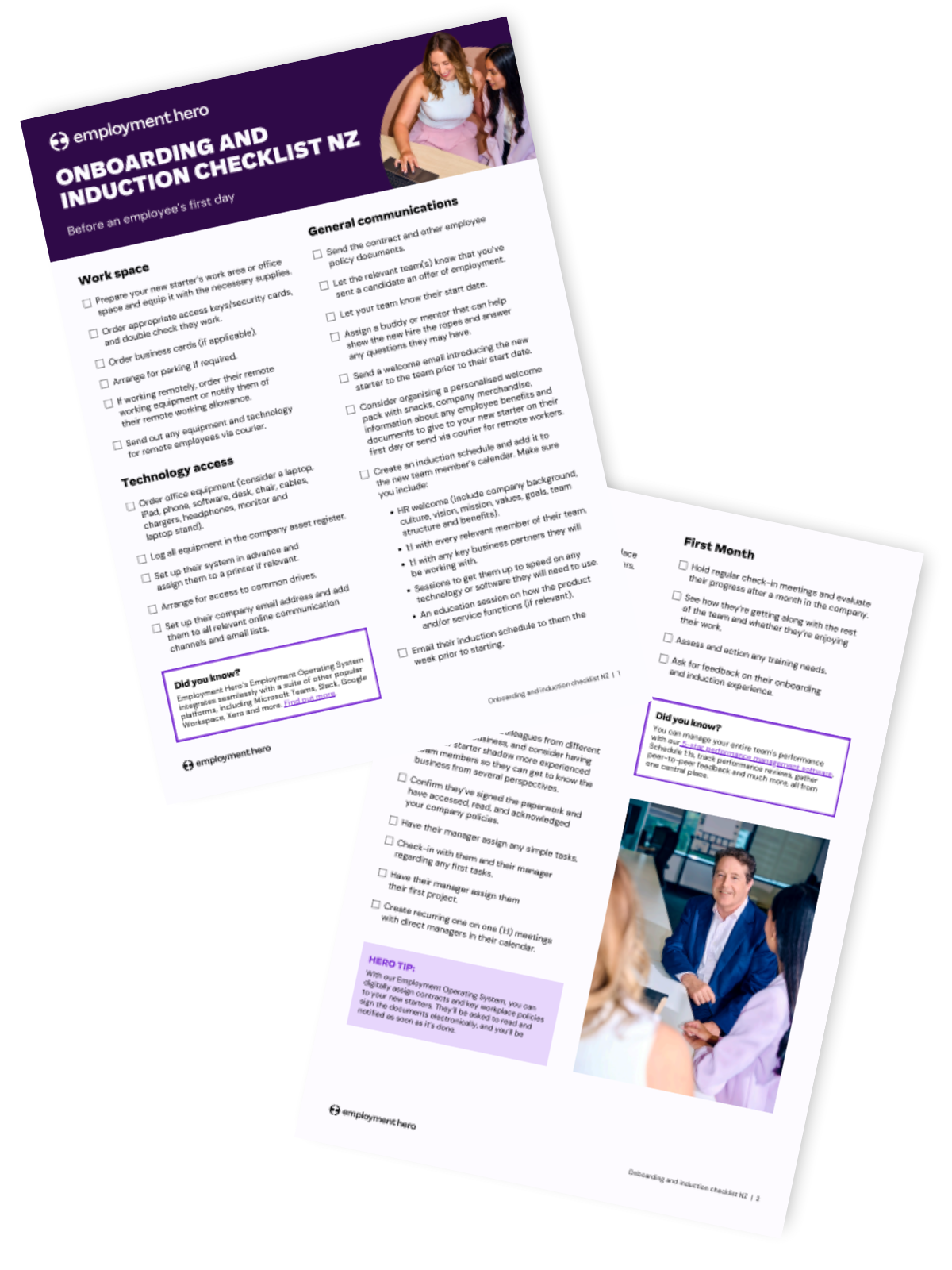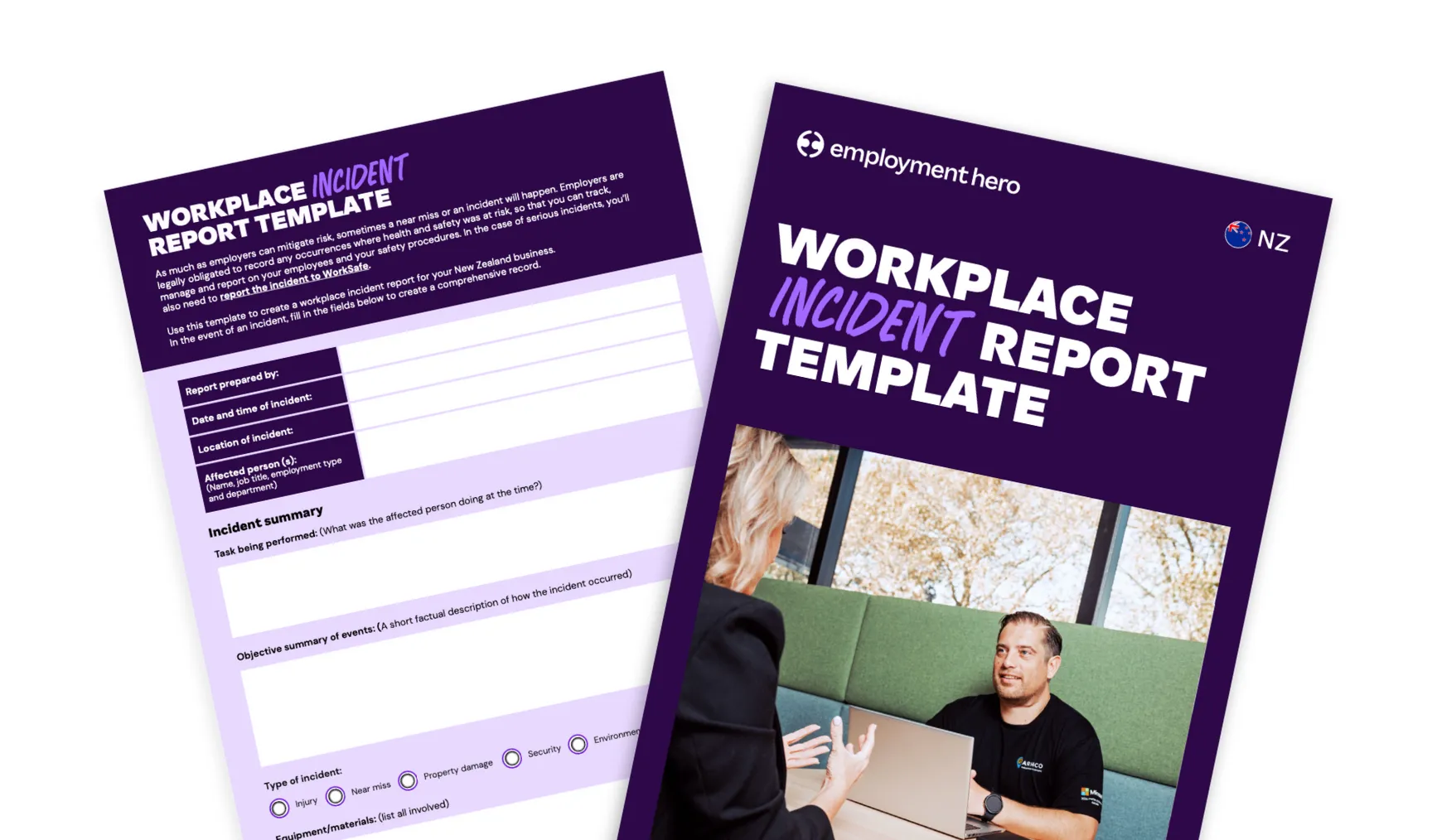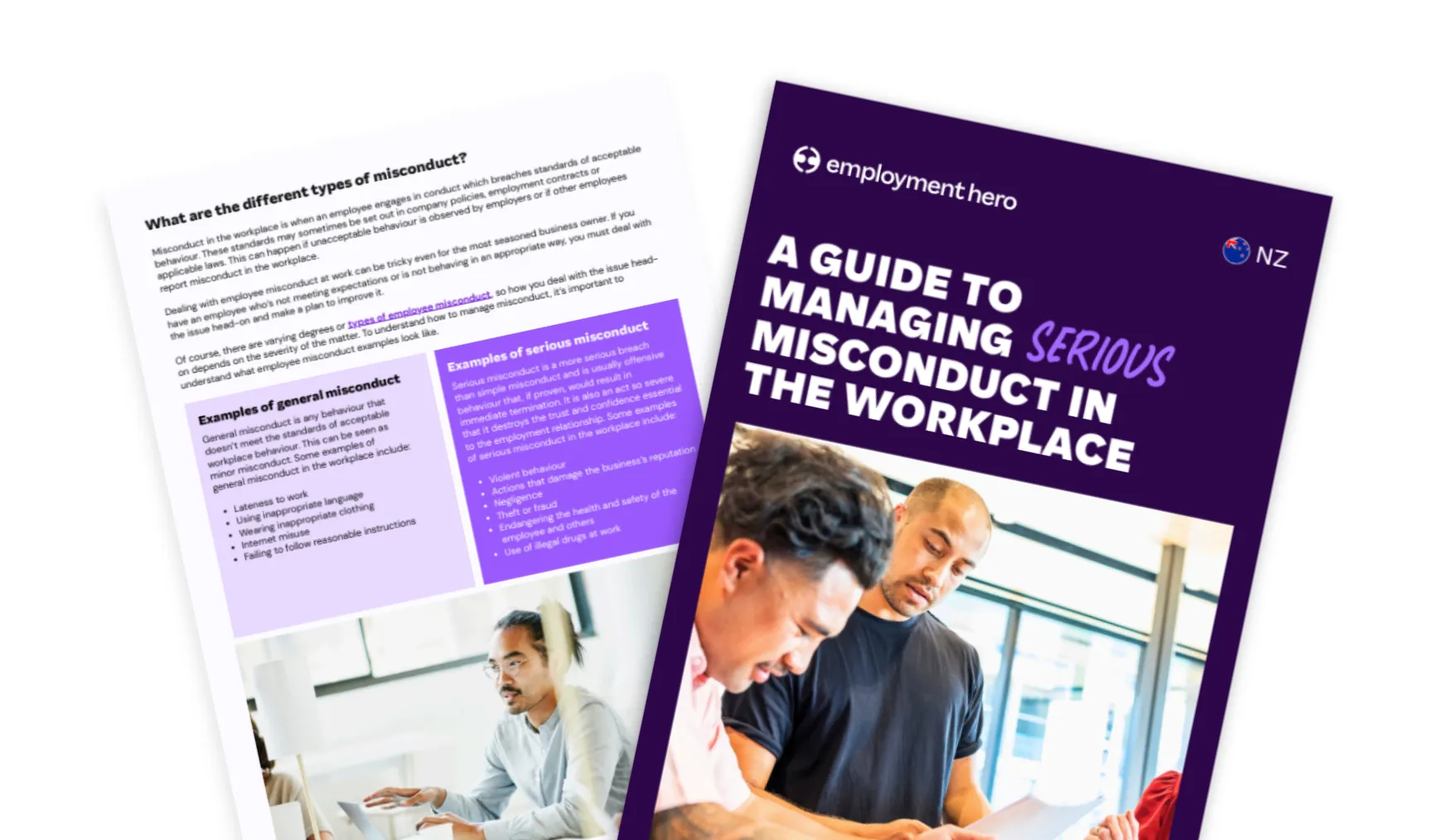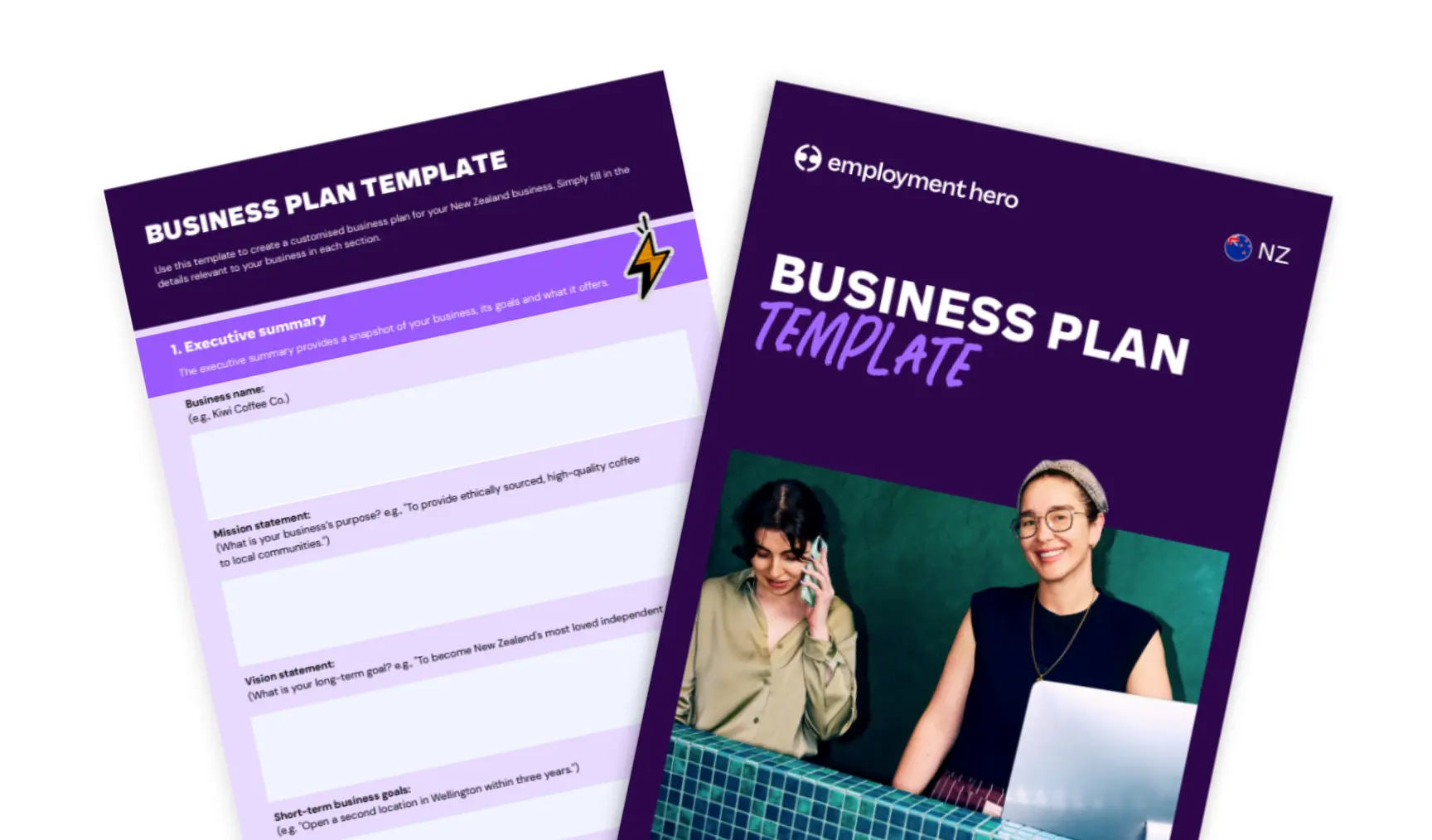Employee Induction and Onboarding Checklist Template [Free Download]
Published
Employee Induction and Onboarding Checklist Template [Free Download]
Published
Give your new employees a great first impression with this onboarding and induction template. Our onboarding and inGive your new employees a great first impression with this onboarding and induction template.
Our onboarding and induction template includes everything you’ll need to create a standout employee induction experience your new starters will remember for all the right reasons.
Using this new employee induction checklist, you can help new employees:
- Get prepared for their first day, week and month
- Cover all bases when it comes to setting up their workspace, technology and communications
What’s included in the employee induction and onboarding checklist template?
- Preparing your new starter’s workspace
- Making sure they have access to all the tools for their new job
- Providing them with important details of the company
- Introducing and welcoming new employees to their team members
Download our onboarding and induction template now.
To further enhance your HR processes, explore our guide on taking HR digital and discover the range of benefits it offers.

Who is this resource for?
HR professionals – If you’re running an HR team, or contributing to HR success, this new starter HR onboarding checklist could be incredibly helpful. Print out and use this HR checklist to use as your own, or use it as a base to cross-check your current new hire onboarding checklist.
Employers – If you’re running a small to medium-sized business, you may not have a dedicated HR team to tick off every onboarding task. This onboarding process checklist is perfect for helping you easily follow along with your new hire’s journey through onboarding and induction.
For small business owners, our small business guide to hiring new employees provides comprehensive information on the hiring process.
Hiring managers – While your HR team or employer may have hired your new direct report, direct managers will ultimately be the ones ensuring that the practical items in the onboarding plan are checked off. This onboarding checklist can help you make sure that nothing is missed as your new hire gets started.
If kept in an easy-to-access place (online or offline), this onboarding template can also help you collaborate with other employees on an onboarding process. Together, you can monitor an employee’s progress and reduce double-handling of tasks. It’s a great way to keep everything in check.
What is an induction process?
An induction process is where the new employee does the bulk of their learning about the business and their role within it. It’s generally a learning process, where the employee is taught about the company by those inside the company (building on any information they may have learned during recruitment). It’s also a chance to share insider information about business goals and plans to help the employee prepare ahead.
Induction can also include the sharing of information about company policies, team structure and a person’s role.
Confused about the difference between onboarding and induction? Although the terms are sometimes used interchangeably, we suggest that an induction plan can be considered part of the onboarding process, but onboarding is not part of an induction process. To learn why, let’s define onboarding.
What is an onboarding process?
Onboarding is a much bigger process than people realise. It includes setting an employee up in different systems, organising their equipment, introducing them to their new team members, establishing goals… The list goes on.
What is the purpose of an onboarding checklist?
Why use a new employee onboarding checklist? In short – it can help you make sure that nothing gets missed in the complex process that is onboarding your new hire!
Onboarding can stretch out from before an employee’s first day to after an employee’s first month. There’s a lot of tasks for the new employee, employer and manager – so it’s well worth keeping track of what has and hasn’t been done.
Onboarding is a collaborative process between employer, employee and hiring manager.
What else should be considered in the onboarding process?
While onboarding checklists get specific about the tasks you need to complete in onboarding, here are a few things you should consider when onboarding new employees to create a meaningful and efficient process.
1. Your company culture
Employees are more likely to invest themselves personally in a company’s success if they feel aligned with the business. It’s essential to get your new employees involved in your company’s culture on day one. The best way to do this is for new hires to spend time with employees from different areas of the business with various levels of seniority.
Likewise, implementing an onboarding buddy system ensures your new hire has someone to talk to, which is so important in the first nerve-wracking weeks of a new job.
2. Company mission, vision and goals
If you want your new starter to embody the company’s mission, vision and values, then you need to share this as part of your onboarding process and show them where the business is headed.
It’s equally important for everyone to understand their own goals and how they relate to the big picture. Communicating the goals of their role during the onboarding process will help new hires focus their efforts on achieving them.
3. Introduction to key team members
Getting to know all the new faces and personalities in a business can seem daunting at first. Your role is to help new employees settle into their new team and get to know the clients, colleagues and managers they will work with to become recognised and integrate naturally.
4. Sharing an employee handbook
Induction and onboarding can cause a bit of information overload for your new hire. While there’s a lot to be communicated, you should also consider distributing an employee handbook with all of the relevant information you’ve shared in the onboarding and induction process.
Having access to an employee handbook can take some of the pressure off having to retain such large amounts of information. It also allows a new employee to access important details in their own time.
Avoiding common mistakes during the onboarding process
A good onboarding process should be effective and efficient. We’ve included a few common mistakes that often happen during onboarding, so you can be sure to avoid them.
Mistake #1. Not following up with a new starter in the lead up to their first day
You don’t need to pester the candidate everyday until they start but checking in a few days before their first day might help them feel more at ease. It could just be to remind them of anything important they might need to bring or give them a run through of how the day will go.
Mistake #2. Not being prepared for your employee induction
Always be prepared. If someone is coming to start a new job, it’s your responsibility to make sure they have everything they need to get up and running as quickly and seamlessly as possible.
Mistake #3. Overloading your new starter with information
Don’t overwhelm your new starter with too much information. This could result in them feeling disheartened and that they’re not a good fit for the role. Instead of having a full on induction day, why not try an induction week? That gives your new starter plenty of time to learn the ropes at their own pace.
Mistake #4. Handing them a mountain of paperwork
No new employee wants to start off their new career with a large amount of paperwork to sieve through. Get all the admin done remotely before their first day with Employment Hero.
Mistake #5. Not introducing them to the team or wider company
You want new starters to feel at home as soon as possible, so make sure everyone knows who they are, why they are there and that they are welcomed.
Mistake #6. Not asking for feedback
Feedback is key for any growing business, and this is the same as growing your people. We suggest sending your new team member a few brief questions at the end of their employee induction process to get some honest feedback about how they found it.
Mistake #7. You stop training
Just because the induction process is over, don’t stop supporting your new employee with their professional development. Make sure there’s always a way for them to learn more – whether that’s about the company or skills specific to their role.
Onboarding compliance in New Zealand
As with so many aspects of business, there are some legal guidelines to follow when confirming employment and onboarding. We’ve included the main compliance obligations, although depending on your specific business, there may be more beyond these.
- Ensure the candidate has the right to work
- Create an employee file to capture and store key information
- Provide a written employment agreement, signed by both parties
- Provide a KiwiSaver enrollment form (or opt-out request form, if the employee prefers)
- Supply an IR330 form for tax code declaration
- Share your workplace policies for acknowledgement by your employee, such as your workplace health and safety policy
Sections of an onboarding checklist
Why have we split our onboarding checklist into sections? Well, apart from making it easier for the reader to digest each collection of tasks – it can help us identify key parts of this important process.
Rather than thinking of onboarding as a one-day orientation, think of it as a continuum: a process that lasts anywhere from 3 to 12 months. Let’s break down these sections and why we’ve included them in our onboarding checklist.
Pre-onboarding
Pre-onboarding can cover a person’s workspace, technology access and initial communications. Let’s start with workspace; it’s where your new employee is going to be spending the majority of their time, after all! It’s a key part of the pre onboarding experience.
Where should someone be spending their time while they are working for the business? Will this be an in-office, remote or hot-desking working environment? How will the person be positioned to communicate with their team and different departments as a new arrival? We’ve covered everything you need to check off.
Technology access
Is there anything worse than trying to navigate new technology on your first day? In our new hire checklist we cover everything to make sure that an employee’s tech is ready to roll and they can hit the ground running.
First day
An exciting part of the onboarding process! An employee’s first day with a business can make or break onboarding. It’s full of important moments and can often be the source of a lot of anxiety for your new hire if not done well.
Day one of a new hire’s employment will have a selection of important tasks, which start by organising a great welcome package and go from there. There are lots of things to check in on and specific details to share.
First week
The first week is an important time for a new employee to get involved in workplace social events, understand a company’s expectations and to begin work under their new job title. In our onboarding checklist we go through the elements that can bring this all together.
First month
Now we’re up and running, your new hire can start to think more strategically about their goals, any additional training they might need and their probation period.
The five phases of employee onboarding
Instead of thinking about an employee onboarding in terms of periods of time, another way of approaching it is with these five phases. This can also help ensure a smooth onboarding process, when used alongside our new hire onboarding checklist template.
Phase one: New hire paperwork
The first phase is about the employee’s pre-arrival to ensure that they have a seamless integration into the business.
One method of doing this is getting all the necessary HR documents for new employees out of the way i.e. their employment contract, payroll forms, legal documents and any other work requirements.
Phase two: A new environment
Phase two focuses on making the employee feel welcome and comfortable in their new environment with a great company culture.
Just like first impressions, a new employee’s first day is important in setting the tone for their experience with the business. Both yourself and other members of the team can make small gestures to ensure a warm welcome.
Phase three: Employee training
The third phase is about being conscious to not overload your new hire with information.
Try to think back what it was like on your first day and all the new things (and names) you had to remember. Therefore, don’t try to hurry over the new employee checklist; instead, extend all the training processes over the first month — everyone learns at a different pace.
Phase four: Goal-setting
Phase four is where you implement your training program so new employees can learn everything they need to do their job well. This is also a time for you to have a discussion with your employee and set goals.
Phase five: Job performance feedback
Be sure to give feedback, not only for recognition of the work they have done but to give them a chance to improve. Following up and checking in even after the training is done is just as important to track their progress and performance. Don’t forget to seek onboarding feedback too.
What comes after the onboarding process?
Your employee is now fully set up to start their work. However, that doesn’t mean that they don’t need further support from you. For a great employee experience, it can be helpful to arrange regular check-ins between the employee and their manager. This ensures that any questions are answered and any blockers in their work can be identified.
You may also choose to enact a probationary period or trial period for their initial time at the company. This allows you to set up a timeframe for assessment of their performance and may have an impact on the legal implications if you choose to end their employment early.
However, it’s important to first check that your business is eligible for a trial or probationary period (for example, some work visas don’t allow them). You should also include the details about this period on the employment agreement. Should you wish to change the terms of their employment during this period, we’d also highly recommend you seek independent legal advice first.
For more information on trial or probationary periods, visit the Employment New Zealand website.
Onboarding FAQs
Usually, hiring new staff comes with a mountain of onboarding paperwork. But that doesn’t mean your new starter’s first day should be all about filling in forms.
To ensure your onboarding process helps set up your new starter for success, get all the paperwork out of the way quickly and efficiently with a paperless onboarding solution like Employment Hero. Completing all the paperwork days or even weeks before the new employee starts, ensures day one is more enjoyable.
Onboarding can make or break how a new employee perceives their company and how productive they will be. So it’s important that you think about the needs of both your business and employees throughout the onboarding experience. To find out more, we’ve included the results from a survey LinkedIn did on what new hires want during onboarding:
What do these results tell you about your current onboarding program? In what ways could you improve it to meet your new employee’s needs?
Employee engagement is one of the most important factors in achieving overall business success and greater productivity. By investing the time and energy into developing your onboarding program, you can use it as a means to boost employee engagement.
Certain elements of onboarding can do just this for your new hire. For example, building strong relationships between your new talent and management and reinforcing the business’s commitment to supporting an employee’s professional growth.
There’s a lot to take in when starting at a new company, so it’s your responsibility to make sure new employees feel settled with their new team as well as introduce them to fellow colleagues or managers they will work with.
An effective employee onboarding program can make the difference on the longevity of an employee’s performance, with 82% of recruits being more likely to stay with their new company for three years. Effective programs are also known to contribute to an 11% increase in employee performance.
There are several ways for HR to evaluate the success of your program. Both qualitative and quantitative measurements can be used, so we’ve listed a couple to get you started:
- Employee feedback– Surveys are always a great option to gather valuable feedback. Some questions to ask could be surrounding role clarity, self-evaluation on their competency, social integration, knowledge of company culture. Interviews are also useful for receiving detailed feedback from both new hires and those leaving the business.
- Retention rates – Ongoing measurement of turnover rates allows an organisation to compare with years past. High turnover could be a reflection of your onboarding process and can cost an organisation up to 300% of the replaced employee’s salary.
- Performance and productivity goals – this is something you should discuss with your new employee in the early stages of onboarding. Having goals that are time bound can make this process easier.
With remote work gaining popularity among employees, remote first working will become an expectation for many employees (see the results from our survey below).
Want to learn more about our onboarding tools?
You’ve learned a lot about onboarding today, and you’re ready to go with your employee onboarding checklist, but what about your onboarding software?
Our paperless onboarding features, complete with digital employee onboarding checklist tools, can make all the difference in creating an effective onboarding process.
Speak to our business specialists today about our helpful HR tools, and book a demo to see them in action.
The information in this article is current as at 2 September 2025, and has been prepared by Employment Hero Pty Ltd (ABN 11 160 047 709) and its related bodies corporate (Employment Hero). The views expressed in this article are general information only, are provided in good faith to assist employers and their employees, and should not be relied on as professional advice. Some information is based on data supplied by third parties. While such data is believed to be accurate, it has not been independently verified and no warranties are given that it is complete, accurate, up to date or fit for the purpose for which it is required. Employment Hero does not accept responsibility for any inaccuracy in such data and is not liable for any loss or damages arising directly or indirectly as a result of reliance on, use of or inability to use any information provided in this article. You should undertake your own research and seek professional advice before making any decisions or relying on the information in this article.
Download the onboarding checklist
Related Resources
-
 Read more: Incident report template NZ: free download for businesses
Read more: Incident report template NZ: free download for businessesIncident report template NZ: free download for businesses
Download our free NZ incident report template. Record and report workplace incidents correctly under HSWA and ACC requirements.
-
 Read more: Serious misconduct in New Zealand: What employers must know
Read more: Serious misconduct in New Zealand: What employers must knowSerious misconduct in New Zealand: What employers must know
Learn what serious misconduct means under NZ law, common examples, and how to manage the process legally and fairly. Protect…
-
 Read more: Free business plan template for New Zealand business owners
Read more: Free business plan template for New Zealand business ownersFree business plan template for New Zealand business owners
Published Published Starting and running a business is a journey that needs direction. That’s why a well-crafted business plan is…





















